SLEEPER COMPARTMENTS IN NEW NORTH AFRICA COACHES
Page 60

Page 61

If you've noticed an error in this article please click here to report it so we can fix it.
An Important Transport Concern in Morocco has Just Added to its Fleet of 400 Vehicles. 50 m.p.h. Main tained on Long Journeys IF there be one country in the world that is specially laid out for the demonstration of the usefulness of the motor coach it is present-day Morocco. When, during the war years, that great soldier and colonist, Marshal Legauty, built the magnificent series of strategic roads which exists to-day, he was looking far beyond the military needs of the moment, and he saw in his mind the immense prosperity which these roads would bring to the country when peace was at last re-established.
The most important of the many transport enterprises in Morocco is the Compagnie Generale de Transports an B46 Marco, usually known as the C.G.T.M. As the result of the enterprise of this powerful concern, regular services of fast luxurious coaches run throughout the entire length of the country. Oudjda, Fez. Mekinez, Tangier, Rabat, Casablanca, Marrakesh and even Agadir, in the far south, are all linked up. The fare schedule is controlled by the Ministry of Public Works.
Freight services are also run and the fleet of the C.G.T.M., which is being steadily increased, comprises 'already 400 vehicles, 250 being coaches and the remaining 150 lorries.
The actual length of the routes served by the coaches amounts to 6,000 kilores., and during the company's financial year of 1929-30 10,000,000 vehiclekiloms. were covered. Moreover, 160,000 passengers were carried, whilst the freight figure was 4,000.000 ton-kiloms. During the first two years of the company's existence various makes of vehicle were employed, but the bulk of the fleet now consists of Panhard-Levassore. One of the first important moves made by the C.G.T.M. was the linking up of Oudjda, on the Algerian border, with Fez and Casablanca.
Roads in modern Morocco go on for hundreds of miles at a time dead straight; they have excellent surfaces, and there is scarcely a cross-road to negotiate. In consequence, the average speed maintained commercially by the coaches is frequently in excess of 50 m.p.h. (It is said to be from 82 k.p.h. to 84 k.p.h.) This kind of service ealls for reliable vehicles. The latest coaches which have been put into service on the Tangiers-Casablanca route are fine sleepers, incorporating the standard Panhard-Levassor 20 h.p. "(French rating) six-wheeled chassis. The bodies have been built by Messrs. Breteau Frkes, of Paris, who are one of the few French coach-building firms alive to the possibilities of industrial bodybuilding.
Railway sleeper-car practice has inspired the design of the new coaches, as there is a corridor on only one side, running for the whole length of the vehicle. Forward are two cabins, each with two transverse berths, and supple
nientary longitudinal bunks, which can be rigged up at night, against the nearside windows. Aft of these is an unusually commodious lavatory, and at the rear is a seven-seater day compartment.
These bodies merit rather special praise for the attention that has been given to small details. It is a serious matter to design a coach body for allthe-year-round work in a country such as Morocco. Passengers must be kept cool in summer, and, if possible, warm in winter, and these ends have been admirably achieved. Morocco is proving quite a favourite winter resort.




























































































